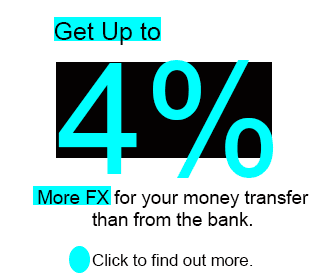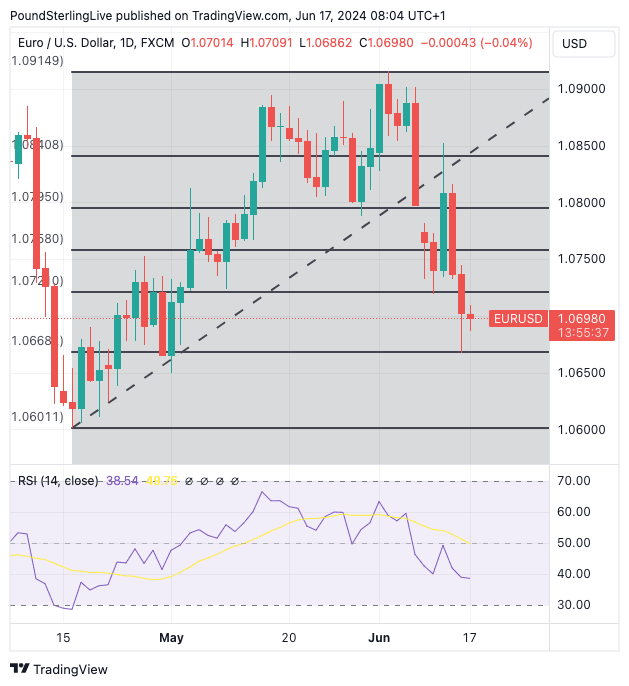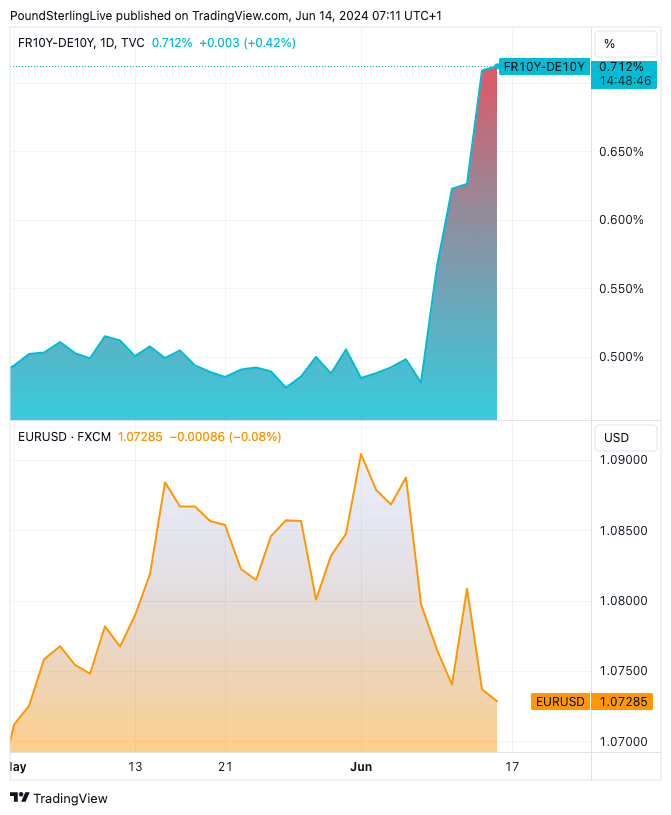EUR/USD Week Ahead Forecast: Eyes on 1.0668
- Written by: Gary Howes
-

Image © Adobe Stock
The Euro to Dollar exchange rate is forecast to remain under pressure in the coming days amidst French political uncertainty.
The exchange rate fell 0.88% last week, further deteriorating the technical setup. As a result, we anticipate further weakness in the coming days.
The next downside target is 1.0668, which is the 78.6% Fibonacci retracement of the April to May rally; we saw the level rejected quite firmly on Friday, suggesting there is in fact support to be found here:
Above: EUR/USD at daily intervals with Fibonacci levels shown. Track GBP/EUR with your own alerts, find out more here.
The Relative Strength Index (RSI) in the lower panel of the chart is at 38 and is pointing lower, which confirms near-term momentum is negative.
The exchange rate is below the 200-day moving average, which we view as a key signal that the broader setup is now negative. While gains can be expected from time to time, they will ultimately give way to the broader downtrend.
Ultimately a test of the April lows at 1.06 is now a potential outcome in the coming two to four weeks.
France will be the main source of fundamental interest for Euro exchange rates in the coming week and any deterioration in sentiment will trigger further weakness.
"EUR/USD can keep falling because of ongoing political issues in France," says Kristina Clifton, a strategist at Commonwealth Bank.
However, we note the week has started on a relatively quiet footing, meaning weekend developments were unremarkable. We wonder whether much of the bad news is already in the price of the Euro, raising the odds of a recovery.
"The market’s reaction has been logical, contained and there is no sign of panic. Investors are reassessing France’s risk premium, but that is normal," says Vincent Mortier, chief investment officer at Amundi. He says that a parliamentary majority for the National Rally, the populist right-wing party led by Marine Le Pen, would not create a "hock to confidence" for investors.
Markets expect President Emmanuel Macron's centrist party to lose the legislative vote, meaning he will have to accommodate a Prime Minister from either the far left or far right. The market's fear is that this would lead to a further deterioration in France's debt situation, which is already reaching concerning levels.
The above chart shows the spread between French and German ten-year bond yields has shot higher as investors sell French bonds in response to fears about the country's debt trajectory in the face of political uncertainty.
The chart shows that as the spread rises, Euro-Dollar comes under pressure, confirming a link between the currency and political anxieties.
"There are concerns that a new parliament could deliver an expansionary and unsustainable fiscal policy. Some analysts fear a scenario like the UK’s September 2022 mini‑budget under Prime Minister Liz Truss," says Clifton.

The European Commission says France's budget for 2024 means it is at risk of flouting the bloc's fiscal rules. (The EU will this year reinstate debt and deficit rules that it suspended during the pandemic).
The Commission subsequently told the French government to take the necessary steps to meet the EU's fiscal rules.
Macron’s government was already struggling to balance the country’s fiscal profile with voter demands for more spending. According to forecasts released in late 2023, the Commission expects debt as a percentage of economic output to rise to 110% of gross domestic product by 2025.
Credit rating agency Standard & Poor's last Friday cut France's credit rating, pouring cold water on the French government's recent efforts to put its public finances back in order.
"Political uncertainty in France is likely to persist for several weeks at least, and add some downward pressure on EUR," says Clifton.













